Tuning the Bass Guitar
The first thing every bass player, from beginner to advanced, must do before he or she can play anything on the bass, is learn how to tune the bass. Tuning is the process of adjusting the pitch of each string of your bass so that they match a particular reference. So what’s that reference?
The bass guitar is an instrument very closely related to the guitar. But unlike guitar, people who learn to play bass guitar generally choose to because of it’s powerful low-end! Most basses have four strings, while most guitars have six. The four bass strings are tuned, from lowest (the thickest string) to highest (the thinnest string), E A D G, which is exactly one octave before the lowest four strings of the guitar. This tuning is called “Standard Tuning”. Because of the similarities between bass and guitar, much of the equipment you can buy for a guitar can be used for the bass, including tuners.
The easiest way to tune your bass is to plug it into a tuner. There are several varieties, from small, hand-held devices to heavy-duty, multipurpose foot pedals. You can buy these from any local music store. “Chromatic tuners” display an arc of lights with the light at the apex being green and the rest being red (typically), all of this being over a letter from A to G. The goal is to tune each string to its specific letter (E A D or G) until only the green light is lit up. If the red lights on the left are lighting up, the string is pitched too low; if the red lights on the right are lighting up, your string pitch is too high.
If you follow each string up to the headstock of your bass, each string has an associated tuning key. This is the thin metal roundish part that adjusts the pitch of the string by tightening or loosening it. If you tighten the string, it will go higher in pitch, making the lights on your tuner go from left to right. If you loosen the string, it will go lower in pitch, making the lights go from right to left. Now, if the bass was strung properly, to tighten the strings you should turn them counter-clockwise, and to loosen them you should turn them clockwise. But this isn’t always definitive. When you’re first learning your bass, it’s okay to guess which way is the correct way and just watch the lights on your tuner until you get to the correct pitch.
Some basses have more than four strings. If you have five strings, you’ve added a “low B string”, meaning that, from lowest to highest, the pitches should be B E A D G. If you happen to have a more rare 6-string bass, then in addition to the low B string, you add a high C string, giving you B E A D G C. There are several mnemonic devices you can se to remember this tuning, such as Elephants Are Dark Grey, and for a 5-string bass, Beautiful Elephants Are Dark Grey.
PROPER RIGHT HAND TECHNIQUE
For beginning bass players, one of, if not the most overlooked aspect of playing is how to position the right hand (or in the case of left handed students, the right hand). And it’s understandable; when a student picks up his or her instrument for the first time, the frets are more attractive. One wants to focus on the fretting hand because that’s where the notes come from. However, a G is the same in Motzart and Metallica in the left hand. The right hand is where style, tone, dynamics, and most importantly, rhythm come from.
Truth be told, there is no “proper” right hand technique. There are several agreed-upon options that all work to give a player a variety of sounds, but there is no “right” way to play any instrument, especially the bass. I will discuss two of the most common techniques here, and I encourage everyone to try them both at length and find what might feel the most natural. I direct this to all players, beginner, intermediate, and advanced. Even someone who has played for 10 years may try a different right hand technique and suddenly feel more comfortable.
When students first begin bass lessons, many students have the tendency to pluck the strings with their thumbs. This is not very effective. I won’t say that it should never ever be used, because there are situations in which plucking with the thumb can be useful. But for now, when you’re beginning, ignore the option. Using one’s fingers, multiple fingers, is much more efficient and will help to create more variety in the sound of the bass. However, the thumb is the most important part of your right technique. The thumb acts as the guide and helps to mute the strings that aren’t being played (95% of the time, only one string will be used and much of a bass player’s focus should be on muting the other strings).
Both techniques I will describe will have the same basic idea. The only real difference between the two will be what you do with your thumb. Rather than explain the rest of the hand position twice, I’ll explain that first.
Hand Position
Sit down in a chair in such a way that your legs make a 90 degree angle at the knee, with your legs making a sort of subtle V shape. Then, raise up your right leg about 3 inches. This can be accomplished by either sliding the heel of your foot straight up the front right leg of the chair, or, if it’s an office-type chair that has only one central leg, put something under the foot like a brick or a small box. You can also buy pedestals from your local guitar store for about $10 that are adjustable and fold down nicely.
Place the bass on your right thigh so that the back of the bass is touching your body. Now angle the neck of the bass so that your body and the back of the bass make about a 45 degree angle; basically, if you look at your left knee, your kneecap should be hidden by the neck of your bass. The bass should be roughly parallel to the floor.
Now, while sitting with your back straight, dangle your right arm between your legs where the right side of your arm is touching your right thigh and the back of your arm is touching the bass. Keep your arm loose. Try to pull your arm straight up by your shoulder muscle to the point that the strings are under your palm. This is how your arm should feel while playing the bass. Notice the shape that your arm. Your hand to your forearm should be a straight line with no bends in the wrist either up or down, left or right. Your forearm and upper arm should make roughly a 90 degree angle (slightly less than 90%). Your shoulder to your upper arm should be a straight line like your wrist and forearm, with your upper arm not being in front or behind your shoulder. Now comes the variance in the thumbs.
Thumb Positioning
1. “Anchored Thumb”
The Anchored Thumb technique is so named because your thumb will at all times be anchored to something. This gives you the stability to move around the strings with your other fingers and helps to mute the strings you’re not using.
Your thumb will be anchored to different places, however, based on which strings you’re playing. If you need to play your lowest-pitched string, your thumb will be anchored to the pickup (if you have multiple pickups, choose the pickup closest to the midpoint between the end of the neck and the bridge). If you need to play the next-lowest pitched string, your thumb will be anchored to the lowest-pitched string. If you need to play your third lowest-pitched string, your thumb will be anchored to the second lowest-pitched string, and so on. Your thumb should move between passages in the song you’re playing, not just per song. For example, on a four-string bass, if you’re playing a G note on the E string, followed by a B ntoe on the A string and then a G on the D string, your thumb should be on the pickup for the first note, the E string for the second note, and the A string for the third note.
Make sure you’re in the position I described earlier where your palm is over the strings. Rotate your thumb under your palm so that your thumbnail is facing the body of the bass. Now place the tip of your thumb on top of the pickup. Your thumb and the bass should be at a 45 degree angle on the bridge side of the instrument. Your hand should resemble a claw. When moving your thumb anchor around the strings, if it’s on the second lowest-pitched string and higher, the side of your thumb through the left side of your palm should be covering the lower strings to prevent them from vibrating.
Place your thumb on the E string and pluck the open A string with your index finger. When you pluck it, you should imagine your finger going all the way through the A string and landing on the E string. With your thumb on the E string, parts of your thumb and index finger should now be touching. It should feel like you’re pinching the E string when you play the A string. Keep your plucking fingers relatively straight, but relaxed. If you freeze your hand right after playing a note on the A string, your index finger should be just slightly bent at the 2nd knuckle, while the 3rd knuckle should be straight. Don’t curl them as you pluck and make them look like fish hooks. All of your plucking should come from the 1st knuckle; your wrist shouldn’t move as you play the bass.
2. “Floating Thumb”
In the Floating Thumb technique, your hand should stay in the position it ended up in after you pulled it up by you shoulder muscles, with your hand covering the strings. Notice that your thumb is much higher than the rest of your fingers. While the Anchored Thumb requires us to make an extra move by re-anchoring each time we stop using a lower string, the the floating thumb will automatically mute lower strings as we move around. If you try to play that G B G figure from the Anchored Thumb explanation, as your fingers reach lower to play the A and D string notes, your thumb automatically slides down the string and mutes the previous strings for you.
The one drawback to the Floating Thumb is that it gives a beginner less stability. It can feel awkward moving around the strings without an anchor and can deprive you of power and articulation. It also makes the “pinching” I described earlier a little harder as you have to have the proper level of control to stop your plucking fingers from going through the next string. However, it’s incredibly helpful for speed and dexterity and it puts less strain on your wrist.
Proper right hand technique takes quite some time to master. It’s the biggest hurdle in learning bass, and it also happens to be one of the first a bass player will need to deal with. It becomes incredibly rewarding, however, and your hands will thank you as you continue your studies of the bass.
I think you’ll find a big difference in your playing with this information, and thanks for reading!
~ Drew Nolde (Music By Ross instructor – Bass and Guitar)




